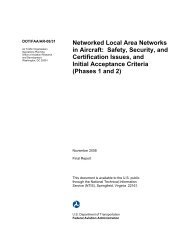Published Report (DOT/FAA/CT-94-36)
Published Report (DOT/FAA/CT-94-36)
Published Report (DOT/FAA/CT-94-36)
You also want an ePaper? Increase the reach of your titles
YUMPU automatically turns print PDFs into web optimized ePapers that Google loves.
number of causes of accidents during final approach, such as<br />
structural failure, engine failure, or midair collision. An<br />
initial estimate is that there are nine possible causes of<br />
accidents on final approach. A tenth possible accident cause, a<br />
collision with aircraft on an adjacent approach, is created with<br />
the implementation of parallel approaches.<br />
For simplicity of model development, it is assumed that the risks<br />
of the 10 potential accident causes are approximately equal. Thus<br />
the contribution of any one of the accident causes would be<br />
approximately one-tenth of the total accident rate. Therefore,<br />
the target safety level for midair collisions on simultaneous<br />
parallel approaches is 4 x 10-8, or:<br />
1 ACC<br />
25 mill APP<br />
To begin the evaluation, CPA analyses indicated that controllers<br />
had the greatest difficulty in maintaining a 500 ft spacing<br />
between aircraft in the event of a 30 degree blunder. Twenty<br />
(20) and 10 degree blunders were all resolvable. The simulation<br />
also demonstrated that only blunders which simulated a lack of<br />
response by the blundering aircraft were sometimes unresolvable.<br />
The pilot's inability to respond may be due to a conflict with<br />
another radio transmission, weather conditions, or a malfunction<br />
of the aircraft. Other studies (Precision Runway Monitor Program<br />
Office, 1991) have estimated that only one percent of the<br />
aircraft blundering 30 degrees off course would be unable to<br />
respond to controller commands.<br />
It is assumed that pilots will be able to resolve conflicts<br />
during visual flight rules (VF'R) conditions, therefore only IMC<br />
conditions are used in this analysis. Based upon these findings<br />
and assumptions, a worst case blunder (WCB) is defined as a 30<br />
degree blunder, under IMC conditions, in which the blundering<br />
aircraft's pilot is unable to respond to the controller's<br />
directions and enters the NTZ.<br />
A factor needed in the risk assessment is the probability of a 30<br />
degree blunder in which the pilot of the blundering aircraft was<br />
unable to comply with ATC instructions (i.e., a WCB). As<br />
mentioned earlier, previous research estimated that the<br />
probability of a no-response blunder was 1/100. Therefore, the<br />
ratio of WCB's to 30 degree blunders is:<br />
1 WCB<br />
100 30-Degree Blunder<br />
The longitudinal alignment of the aircraft, relative to the<br />
threshold, on adjacent ILS approaches, was found to be an<br />
important factor in conflict resolution. The probability of a<br />
41

















